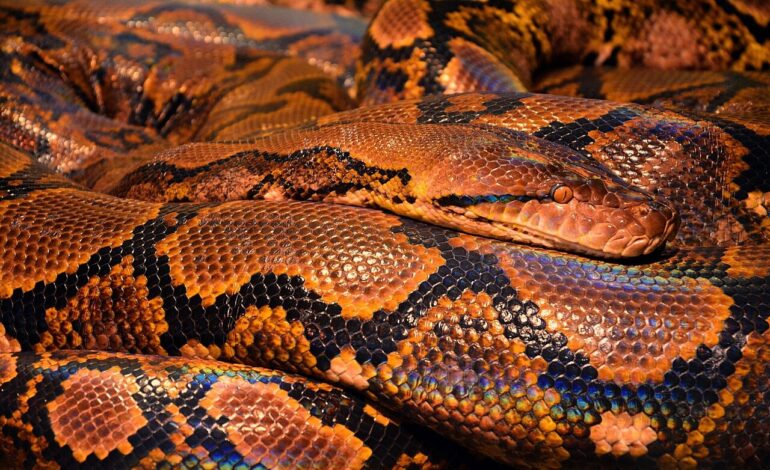Burmese pythons are not just big snakes, growing to more than 18 feet and 200 pounds, but big eaters, taking on prey as large as deer.
Biologists at the University of Cincinnati found that it’s not just the size of its head and body that puts almost everything on a python’s menu. They evolved super-stretchy skin between their lower jaws that allows them to consume prey up to six times larger than similarly sized snakes.
The study was published in the journal Integrative Organismal Biology.
Since most snakes swallow prey whole, they must have wide mouths to accommodate a meal. Unlike our lower jawbone, the lower jawbones of snakes are not connected, allowing them to open wide.
But UC College of Arts and Sciences professor Bruce Jayne found that Burmese pythons have super-stretchy skin between their lower jaws that allows them to consume animals even bigger than a typical snake’s highly mobile jaws would permit.
“The stretchy skin between left and right lower jaws is radically different in pythons. Just over 40% of their total gape area on average is from stretchy skin,” Jayne said. “Even after you correct for their large heads, their gape is enormous.”
In his lab, Jayne studies the limits of animal anatomy and how that influences their behavior. In 2020, he identified a never-before documented means of snake movement he called lasso locomotion that enables some snakes to climb wide cylinders or smooth tree trunks.
“It’s intriguing to think about the different potential limits of what animals can do in nature,” Jayne said. “What does anatomy permit? What does it limit?”
Pythons are constrictors. They bite their prey and quickly wrap their powerful coils around it, fatally cutting off the animal’s vital blood flow, before consuming it whole at their leisure.
The bigger the prey, the more energy a snake derives from a meal. For pythons, that means not having to hunt as often, which can carry extensive risk in a world full of busy roads and dangerous predators.
Along with pythons, Jayne studied the gape size of brown tree snakes, a mildly venomous arboreal specialist that hunts birds and other animals in the forest canopy. Brown tree snakes were introduced to Guam in the 1950s and have since wiped out many bird species.
Besides measuring the snakes, Jayne also measured the dimensions and weight of potential prey animals. This allowed Jayne to use snake size to predict the maximal size of its prey and the relative benefits of consuming different types such as alligators, chickens, rats or deer.
Small snakes derive greater benefits in relative prey mass from a modest increase in gape size, the study found. This gives python babies an early advantage in taking on a broader range of prey compared to other snakes their size, Jayne said.
“A bigger baby has a wider variety of prey it can consume. By being big, snakes can exploit a wider variety of prey than smaller snakes,” Jayne said.
Being big also helps snakes avoid becoming meals themselves. Snakes fall prey to everything from wading birds to minks and raccoons to alligators and other snakes.
“Once those pythons get to a reasonable size, it’s pretty much just alligators that can eat them,” Jayne said. “And pythons eat alligators.”
Like invasive brown tree snakes in Guam, Burmese pythons are wreaking havoc on the ecology of Everglades National Park where they were introduced through the accidental or intentional release of captive animals in the exotic pet trade in the 1980s.
Study co-author Ian Bartoszek works as an environmental science project manager for the Conservancy of Southwest Florida, where he has led a project to track pythons. They implant radio transmitters in male snakes during breeding season and follow them to find females before they can lay more clutches of eggs. A big female python can lay more than 100 eggs.
Researchers routinely find deer hooves and the remains of other big animals in their stomachs. Bartoszek photographed one python regurgitating a full-grown white-tailed deer.
“Some things you can’t unsee on this python project,” he said. “Last season, we removed one snake that weighed 215 pounds.”
A juvenile python consumed a baby deer that weighed 6 pounds or 60% of the snake’s total weight.
“We have removed 25,000 pounds of python from an area of 100 square miles,” Bartoszek said. “They’re clearly preying on an assortment of native wildlife, which has a cascading effect in the ecosystem.
“The Everglades ecosystem is changing in real time based on one species, the Burmese python.”
By knowing the upper limits of the prey invasive snakes can eat, biologists hope to understand how they’re influencing the food chain.
“It’s not going to help to control them,” UC’s Jayne said. “But it can help us understand the impact of invasive species. If you know how big the snakes get and how long it takes for them to get that size, you can place a rough upper limit on what resources the snake could be expected to exploit.”
Just because a snake can swallow a huge animal doesn’t mean it will hunt prey that large. Jayne said many snakes prefer to hunt much smaller animals than what they can actually consume.
The good news is that pythons rarely attack people. Bartoszek said the only defensive encounters he’s had with wild pythons are with females guarding their nests.
“It’s way more dangerous to drive there than to work with the snakes,” he said.
More information:
Bruce C Jayne et al, Scaling Relationships of Maximal Gape in Two Species of Large Invasive Snakes, Brown Treesnakes and Burmese Pythons, and Implications for Maximal Prey Size, Integrative Organismal Biology (2022). DOI: 10.1093/iob/obac033
Provided by
University of Cincinnati
Citation:
Pythons are true choke artists: Size alone doesn’t explain how they can eat such big prey (2022, September 16)
